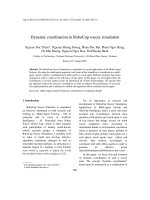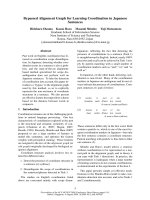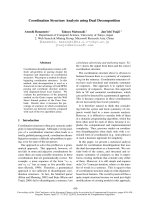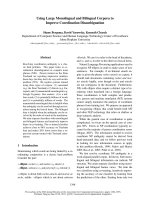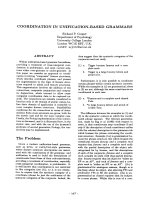coordination chemistry
Bạn đang xem bản rút gọn của tài liệu. Xem và tải ngay bản đầy đủ của tài liệu tại đây (785.28 KB, 77 trang )
COORDINAT
ION
CHEMISTRY
II
BONDING, INCLUDING CRYSTAL FIELD THEORY
AND LIGAND FIELD THEORY
BASIS FOR BONDING
THEORIES
Models for the bonding in
transition metal complexes must be
consistent with observed behavior.
Specific data used include stability (or
formation) constants, magnetic
susceptibility, and the electronic (UV/Vis)
spectra of the complexes.
BONDING
APPROACHES
Valence Bond theory provides the
hybridization for octahedral complexes. For
the first row transition metals, the
hybridization can be: d2sp3 (using the 3d, 4s
and 4p orbitals), or sp3d2 (using the 4s, 4p
and 4d orbitals).
The valence bond approach isn’t used
because it fails to explain the electronic
spectra and magnetic moments of most
complexes.
CRYSTAL FIELD
THEORY
In crystal field theory, the
electron pairs on the ligands are viewed as
point negative charges that interact with
the d orbitals on the central metal. The
nature of the ligand and the tendency
toward covalent bonding is ignored.
D ORBITALS
CRYSTAL FIELD THEORY
Ligands, viewed as point charges, at the corners of
an octahedron affect the various d orbitals differently.
CRYSTAL FIELD
THEORY
CRYSTAL FIELD THEORY
The repulsion
between ligand lone pairs and
the d orbitals on the metal
results in a splitting of the
energy of the d orbitals.
D ORBITAL
SPLITTING
__ __ e
g
dz2 dx2-y2
__ __ __ __ __
0.6∆o
Spherical field
0.4∆o
__
dxy
__ __ t
2g
dxz dyz
Octahedral field
∆o
D ORBITAL
SPLITTING
In some texts and articles, the
gap in the d orbitals is assigned a value of
10Dq. The upper (eg) set goes up by 6Dq,
and the lower set (t2g) goes down by 4Dq.
The actual size of the gap varies
with the metal and the ligands.
D ORBITAL
SPLITTING
The colors exhibited by most
transition metal complexes arises from the
splitting of the d orbitals. As electrons
transition from the lower t2g set to the eg
set, light in the visible range is absorbed.
D ORBITAL SPLITTING
The splitting
due to the nature of the ligand
can be observed and measured
using a spectrophotometer.
Smaller values of ∆o result in
colors in the green range.
Larger gaps shift the color to
yellow.
THE
SPECTROCHEMICAL
SERIES
Based on measurements for a
given metal ion, the following series has
been developed:
I-
THE SPECTROCHEMICAL
SERIES
The
complexes of cobalt
(III) show the shift in
color due to the
ligand.
(a) CN–, (b) NO2–,
(c) phen, (d) en, (e)
NH3, (f) gly, (g) H2O, (h)
ox2–, (i) CO3 2–.
LIGAND FIELD
STRENGTH
OBSERVATIONS
1. ∆ increases with increasing oxidation
o
number on the metal.
Mn+2
group of metals.
LIGAND FIELD
THEORY
Crystal Field Theory completely ignores
the nature of the ligand. As a result, it
cannot explain the spectrochemical series.
Ligand Field Theory uses a molecular
orbital approach. Initially, the ligands can be
viewed as having a hybrid orbital or a p
orbital pointing toward the metal to make σ
bonds.
OCTAHEDRAL
SYMMETRY
/>symmetry/octahedral.html
LIGAND FIELD THEORY
Consider the sigma bonds to all six ligands
in octahedral geometry.
Oh
E
Γσ
6
8C3 6C2 6C4
0
0
2
3C2
i 6S4 8S6 3σh 6σd
2
(=C4 )
2
0
This reduces to A1g + Eg + T1u
0
0
4
2
LIGAND FIELD THEORY
The A1g group
orbitals have the same
symmetry as an s orbital on the
central metal.
LIGAND FIELD THEORY
The T1u group
orbitals have the same
symmetry as the p orbitals on
the central metal.
(T
representations are triply
degenerate.)
LIGAND FIELD THEORY
The Eg group
orbitals have the same
symmetry as the dz2 and dx2-y2
orbitals on the central metal.
(E representations are
doubly degenerate.)
LIGAND FIELD THEORY
Since the ligands
don’t have a combination with t2g
symmetry, the dxy, dyz and dxy
orbitals on the metal will be nonbonding when considering σ
bonding.
LIGAND FIELD THEORY
The molecular
orbital diagram is
consistent with the
crystal field
approach.
Note that the
t2g set of orbitals is
non-bonding, and
the eg set of orbitals
is antibonding.

